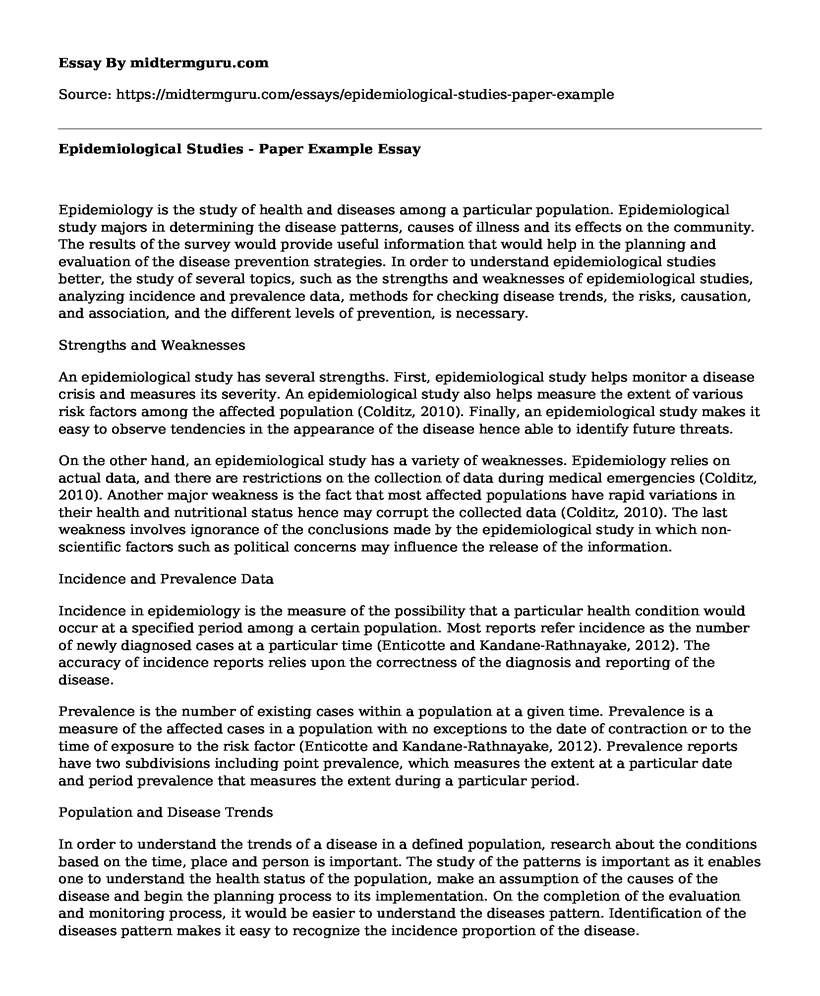Epidemiology is the study of health and diseases among a particular population. Epidemiological study majors in determining the disease patterns, causes of illness and its effects on the community. The results of the survey would provide useful information that would help in the planning and evaluation of the disease prevention strategies. In order to understand epidemiological studies better, the study of several topics, such as the strengths and weaknesses of epidemiological studies, analyzing incidence and prevalence data, methods for checking disease trends, the risks, causation, and association, and the different levels of prevention, is necessary.
Strengths and Weaknesses
An epidemiological study has several strengths. First, epidemiological study helps monitor a disease crisis and measures its severity. An epidemiological study also helps measure the extent of various risk factors among the affected population (Colditz, 2010). Finally, an epidemiological study makes it easy to observe tendencies in the appearance of the disease hence able to identify future threats.
On the other hand, an epidemiological study has a variety of weaknesses. Epidemiology relies on actual data, and there are restrictions on the collection of data during medical emergencies (Colditz, 2010). Another major weakness is the fact that most affected populations have rapid variations in their health and nutritional status hence may corrupt the collected data (Colditz, 2010). The last weakness involves ignorance of the conclusions made by the epidemiological study in which non-scientific factors such as political concerns may influence the release of the information.
Incidence and Prevalence Data
Incidence in epidemiology is the measure of the possibility that a particular health condition would occur at a specified period among a certain population. Most reports refer incidence as the number of newly diagnosed cases at a particular time (Enticotte and Kandane-Rathnayake, 2012). The accuracy of incidence reports relies upon the correctness of the diagnosis and reporting of the disease.
Prevalence is the number of existing cases within a population at a given time. Prevalence is a measure of the affected cases in a population with no exceptions to the date of contraction or to the time of exposure to the risk factor (Enticotte and Kandane-Rathnayake, 2012). Prevalence reports have two subdivisions including point prevalence, which measures the extent at a particular date and period prevalence that measures the extent during a particular period.
Population and Disease Trends
In order to understand the trends of a disease in a defined population, research about the conditions based on the time, place and person is important. The study of the patterns is important as it enables one to understand the health status of the population, make an assumption of the causes of the disease and begin the planning process to its implementation. On the completion of the evaluation and monitoring process, it would be easier to understand the diseases pattern. Identification of the diseases pattern makes it easy to recognize the incidence proportion of the disease.
Risk, Association and Causation
Not only does epidemiology clarify on the association between exposure to risk factors and the impacts on health but also it emphasizes on identifying the causes of the disease. A cause of a disease is any incident, characteristic, condition, or combination of any of the above that plays a role in the creation of a disease. A cause can be either necessary or sufficient (Kundi, 2006). A necessary cause is one in which a disease cannot manifest in its absence while a sufficient cause is one which produces the disease. Before creating an association with the disease, it is important for one to distinguish between the causal and non-causal factors using Bradford Hill criteria (Kundi, 2006). Hills criteria provide several features, including strength, response to dosage, reversibility, regularity, solid evidence monitoring and plausibility, that aid in identifying the causal from non-causal associations.
Levels of Prevention
There are four levels of prevention of a disease. The first tier is primordial prevention, which aims at eradicating or minimizing the impact of the initial condition that causes the disease (Bracken, 2011). The second level of prevention is primary prevention that aims at eliminating the necessary cause condition or factor. The secondary level is the third prevention level, which tries to eradicate the disease at its early stages. The final level is the tertiary level that aims at treating and quarantining the patient.
References
Bracken, M. (2011). Preregistration of Epidemiology Protocols. Epidemiology, 22(4), 607-608. http://dx.doi.org/10.1097/ede.0b013e31821c06c5
Colditz, G. (2010). Overview of the Epidemiology Methods and Applications: Strengths and Limitations of Observational Study Designs. Critical Reviews In Food Science And Nutrition, 50(sup1), 10-12. http://dx.doi.org/10.1080/10408398.2010.526838
Enticott, J. & Kandane-Rathnayake, R. (2012). Prevalence versus incidence. Transfusion, 52(9), 1868-1870. http://dx.doi.org/10.1111/j.1537-2995.2012.03687.x
Kundi, M. (2006). Causality and the Interpretation of Epidemiologic Evidence. Environmental Health Perspectives, 114(7), 969-974. http://dx.doi.org/10.1289/ehp.8297
Cite this page
Epidemiological Studies - Paper Example. (2021, Jun 10). Retrieved from https://midtermguru.com/essays/epidemiological-studies-paper-example
If you are the original author of this essay and no longer wish to have it published on the midtermguru.com website, please click below to request its removal:
- Paper Example on Physician-Assisted Suicide and Hospital Policy
- The Nursing Issue to be Presented - Research Paper
- Final Reflection Assignment - Nursing Profession
- Essay Sample on Nursing Manager Hiring Process
- Tailor-Made Solutions: Healthcare Professionals Embrace Case Management for Diabetes - Essay Sample
- Celiac Disease: Foods to Avoid, Gluten-Free Diet & Health Benefits - Essay Sample
- Anxiety in Autism: Mediating Role in Academic Behaviour & Skills Development - Research Paper







